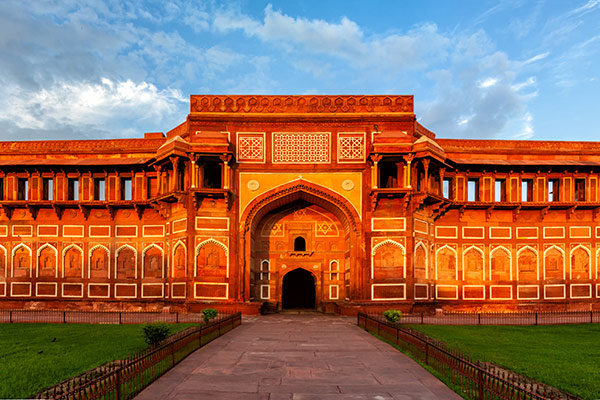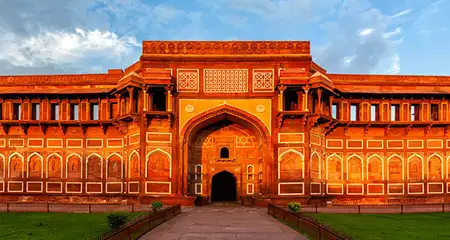The magnificent Agra Fort is one of the most remarkable monuments built in India during the reign of the Mughals. This 94-acre structure is situated in the city of Agra along the banks of the Yamuna River, about 3 km away from the renowned Taj Mahal. If you are planning a trip to Agra, make sure to include this erstwhile residence of the Mughals in your itinerary. Also, book your hotels in Agra in a location that gives you easy access to the Agra Fort, Taj Mahal, and other attractions in the city.
Before you plan your trip, take some time to read this blog. Here is everything you should know about the Agra Fort including its history, architecture, timings, entry fee, lesser-known facts, and much more.
Agra Fort Information
| Location | Agra |
| Timings | Sunrise to sunset; every day |
| Entry | Only through Amar Singh Gate |
| Entry Fee | ₹ 40 (Indians); ₹ 650 (foreigners); free entry for kids below the age of 15 years |
| Still and Video Cameras | Allowed |
| Commissioned by | Emperor Akbar |
| Architectural Style | Mughal style |
| Status | UNESCO World Heritage Site |
| Area | 94 acres |
| Year of Establishment | 1573 |
| Best Time to Visit | October to February |
| Material Used | Red sandstone and marble |
Agra Fort: History
Did you know that this fort in Agra was originally a fortress made of bricks, owned by the Chauhan Rajputs? Historians note that after the First Battle of Panipat in 1526, Ibrahim Lodhi had moved to Agra and was living in the fort. He was conquered and killed by Babur, the first Mughal ruler, who then captured the fort and built a Baori or a stepwell in it.
When the fort came under the control of Akbar, he decided to make it his capital. However, at that time, the fort was disintegrating and losing its glory and grandeur. So Akbar rebuilt the fort with red sandstone in its exteriors and bricks in its inner core. It took the diligent and laborious work of 1,444,000 builders for 8 long years to complete the construction of this fort in 1573.
Though the construction of the Agra Fort is attributed to Akbar, it was built into what we see today under the reign of Shah Jahan, the grandson of Akbar. He demolished many buildings inside the fort and rebuilt palaces and mosques using white marbles. Later, after the battle of Samogarh in 1658, the fort came under the control Aurangzeb, the son of Shah Jahan, who locked his father here for 8 years until his death.
After the death of Shah Jahan, the fort has been seized and plundered by many emperors and rulers. In 1803, during the Second Anglo-Maratha War, the Agra Fort was taken over by the British who handed its authority to the Government of India after independence.
Agra Fort Architecture
The opulent Agra Fort is made using red sandstone and marble and features the Mughal style of architecture. When viewed from above, the fort displays the shape of a semicircle and is enclosed by massive double battlemented walls made of red sandstone. These walls are about 2 km in perimeter and 70 feet in height. The fort has four gates namely Delhi Gate, Amar Singh Gate, Hathi Pol, and Ghaznin Gate. Of these, the Delhi Gate is the largest and was used as Akbar’s formal gate. Visitors are given access to the fort only through the Amar Singh Gate.
There are splendid rooms, magnificent mosques, and beautiful halls inside this fort. The main structures and monuments at the fort include public and private halls called Diwan-i-Am and Diwan-i-Khas, royal pavilions that house masjids, royal baths made using marble, a mirror palace or Sheesh Mahal, and courtrooms, among others. It is believed that the fort once had over 5000 structures and monuments inside it. However, only a dozen of these stood the test of time.
Agra Fort: Today
Today, the Agra Fort is one of the best forts in India and is a popular tourist destination in Agra after the Taj Mahal. In 1983, the fort was given the status of UNESCO World Heritage Site. You can purchase entry tickets to the fort at the Amar Singh Gate and also rent audio guides from the booth inside the entrance. The Sadar Bazaar, one of the top shopping places in Agra, is located near the fort. It is one of the famous places to visit in Agra.
Agra Fort Light and Sound Show
The Government of UP organizes an evening light and sound show at the fort. The light and sound show at the Agra Fort takes you on a visual journey through its illustrious past. Counted among the best light and sound shows in India, it is one of the top attractions in Agra Fort.
- Timings: 30 minutes after sunset; every day
- Shows: Hindi and English
- Tickets: ₹ 70 for Indians; ₹ 200 for foreigners; ₹ 40 for students
Things to See in Agra Fort
The fort comprises several palaces, halls, and other monuments built at different points of time in history. The major things to see in Agra Fort include:
- Jahangir Mahal, the red sandstone palace built for Jahangir by his father Akbar
- Jahangir‘s Hauz, the monolithic tank or bathtub built for Jahangir
- Bengali Mahal, the palace of Akbar which is said to have many secret underground passages
- Khas Mahal, a white palace built by Shah Jahan featuring floral etchings and Jaali-styled windows. The palace is positioned such that it gives you a distance view of the Taj Mahal.
- Anguri Bagh or the Garden of Grapes, a garden built by Shah Jahan in front of Khas Mahal
- Akbari Mahal, the palace where Akbar spent the last years of his life
- Sheesh Mahal, a mirror palace built by Shah Jahan that features tiny glass-mosaic decorations.
- Babur’s Baoli, a Baoli or stepwell. This was the first modification made to the fort by Babur.
- Shahjahani Mahal, a white marble palace featuring an octagonal tower, side rooms, and a large hall
- Musamman Burj, an octagonal building with a clear view of the Taj Mahal. This is the place where Aurangzeb imprisoned his father, Shah Jahan, who spent 8 years of his life watching his wife’s memorial from a distance.
- Nagina Masjid, a mosque built for the ladies. It is said that below the mosque was the Mina Bazaar, where the epic romance between Jahangir and Nurjahan blossomed.
- Macchi Bhavan, a large terrace with hallways that connect to various chambers of the fort
- Ghaznin Gate, a gate that originally belonged to the Tomb of Muhmud of Ghazni and was brought to the fort during the rule of British
- Diwan-i-Khas, the hall of private audience with tall arched doorways made of white marble. The renowned Peacock Throne of Shah Jahan with the famous Kohinoor diamond used to be kept here before it was shifted to Delhi.
- Diwan-i-Am, the hall for public audience built by Shah Jahan
- Moti Masjid aka the Pearl Masjid, a mosque which is currently not accessible to the public. The private shrine of Shah Jahan, namely Mina Masjid, is situated close to the Moti Masjid.
Lesser known facts about Agra Fort
- In 2004, the Agra Fort had won the Aga Khan Award for Architecture and to commemorate the win, a special stamp was issued by India Post.
- The Agra Fort features in The Sign of the Four, a Sherlock Holmes mystery novel written by Sir Arthur Conan Doyle.
- In 1638, when Shah Jahan decided to move from Agra to Delhi, he decided to build the Red Fort taking inspiration from Agra Fort.
If you are planning for Agra trip, you can select best couple friendly hotels in Agra.
Attractions near Agra Fort
- Jama Masjid (700 m)
- Taj Mahal (2.9 km)
- Itmad-ud-Dulah’s Tomb (3.5 km)
- Sadar Bazaar (3.5 km)
- Mehtab Bagh (5.5 km)
- The Red Taj (6.2 km)
- Sikandra Fort and Akbar’s Tomb (12.6 km)
The importance of Agra Fort is often overshadowed by the Taj, but this one-time residence of the Mughals has a charm of its own. Now that you know everything about this magnificent fort in Agra, aren’t you all set to explore it and see the many layers of history etched here in stone?




























